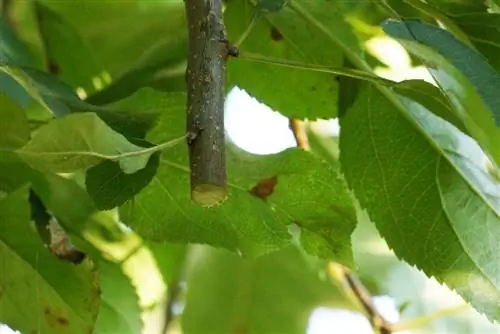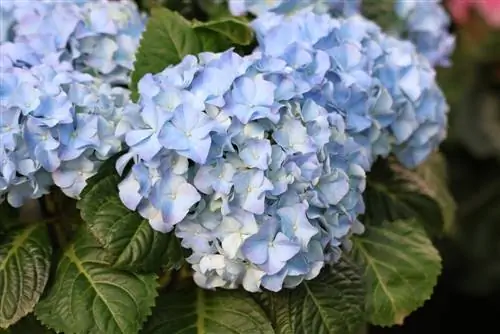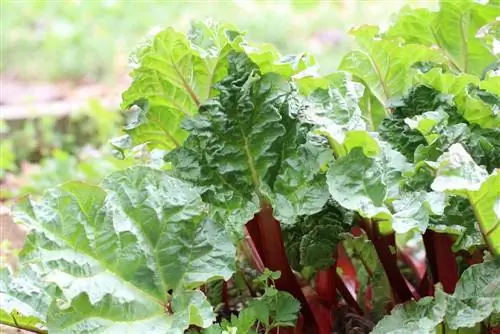- Author admin [email protected].
- Public 2023-12-17 03:39.
- Last modified 2025-01-24 12:45.
Opinions differ when it comes to wound closure on trees after pruning. For advocates of sealing the cut surfaces, it is an indispensable measure. The other side vehemently proclaims the fairy tale of wound closure. This causes uncertainty among home gardeners, which this guide clears up. Read here why it makes sense to trust in the self-healing powers of a tree and to avoid sealing it. Nevertheless, under certain circumstances it is advantageous for the healing process to treat a cut professionally. How to do it right.
Wound sealing fallacy
Modern findings in tree science have exposed wound closure after tree pruning as a fallacy. For many decades, gardeners sealed cuts airtight with wax, tree tar, emulsion paints and similar products. In the best belief that they were helping their tree heal its wounds and protect it from fungal attack, hobby gardeners did the opposite. Why numerous trees subsequently stopped growing, became diseased and even died remained a mystery for a long time.
It was only in the mid-1980s that the research results of the American forest scientist Alex Shigo shed light on the matter. The 'father of modern tree care' dismantled more than 15,000 trees with a saw to study the reaction in the wood to this wounding. He discovered that wound healing in a tree is completely different than in humans and animals. A plaster is applied to a skin injury, for example on the fingertip. Within a short time, the old, injured cells are replaced by new, identical cells, so that the fingerprint remains unchanged throughout life. Trees lack this ability to reproduce injured tissue identically. They use a different strategy that is hindered by bandages in the form of wound closure.
The bottom line from 26 years of intensive research is: Wound closure does not prevent rot and disease, but rather has the opposite effect. With this insight, he shook the foundations of traditional tree surgery and triggered a rethink among commercial and private arborists.
Self-healing powers top wound closure
In order to understand Alex Shigo's findings and implement them in your own garden, a short excursion into tree biology is helpful. The following overview shows in a simplified form the process in the wood after the tree has been cut:
- Injured tissue in wood does not heal like human skin
- Instead, the edge of the wound is covered with a layer of callus
- The injured wood is encapsulated and decomposes
- Fresh, active wood (cambium) forms above a barrier line to the rotting wound wood
After a tree is cut, a race takes place between the growth of young cambium and the decomposition of the injured tissue. The quicker and more unhindered the overflow of a cut, the less damage is caused by the dying wood.
It is obvious that a wound closure agent significantly impairs this process. Fresh cambium encounters a chemical barrier and cannot overcome the decomposing tissue quickly enough. In the race against decay, the natural self-healing powers fall behind, so that in the worst case, the entire branch or trunk is left helpless to decay.
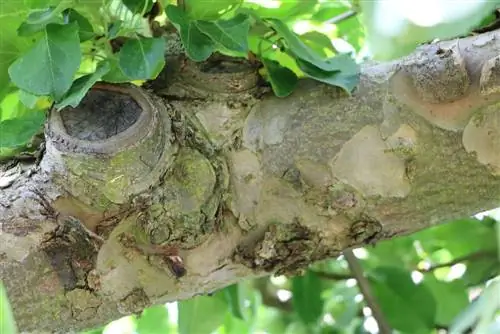
What makes matters worse is that sealing the cut surface plays into the hands of germs and fungal spores. The change between sun, rain, heat and cold causes cracks within the seal, which pathogenic germs use as a welcome portal of entry. In combination with existing microorganisms, in the pleasant microclimate under the protective film, decomposition progresses briskly, while the healing overflow is hindered by fresh cambium.
Tip:
Looking at a cross section of wood a few years after a wound, it is clear that a tree gives up damaged tissue and simply overflows with new wood to continue its growth. Even without a cross-section, this process can be visually traced through bulges in the trunk.
When are wound closure products useful?
It is still not recommended to rigorously ban wound closure products from the garden. Under special conditions, sealing cut surfaces can be useful and advantageous. In the following 2 exceptional cases, you can help your tree by treating cuts:
Winter cut
For a variety of tree species, winter is the best time for shape and maintenance pruning. Since trees are in their sap dormancy between November and February, cambium cannot form to cover pruning wounds. To ensure that this layer of cell division on the outer edge of the wound does not freeze or dry out until the beginning of the growing season, a wound closure agent is applied at this point. How to do it right:
- Smooth the edge of the wound with a sharp knife
- Seal the edge with a wound closure
- Do not completely coat the cut surface
The valuable cambium can be seen as the first layer under the bark. Only this outer ring is sealed in winter so that the self-healing process can begin unhindered in spring.
Chipped bark
If superficial wounds occur because the bark has chipped off or was damaged as a result of being bitten by game, a larger layer of cambium is exposed unprotected. This special case is also an area of application for wound closure agents. Now the danger does not come from fungi, mold or pests. Rather, larger areas without bark are at risk of drying out. Here you apply the sealant to the exposed wooden surface until fresh bark has formed over it.
Tip:
Damaged areas due to bark detachment can alternatively be covered with black foil until new bark has formed from the cambium remains. Likewise, repeated coating with clay prevents drying out while new bark is forming.
Recommended wound closure agents
Since traditional tree surgery has been reoriented towards biologically based tree care according to Alex Shigo, the range of wound closure products on the market has been steadily decreasing. What remains are ecologically sensible preparations that support the healing process after a winter pruning or bark removal. The following products have emerged as recommended:
Wax-resin combination of shaft
The product is based on resins that are naturally secreted by trees after injuries. These resins destroy bacteria and fungal spores and promote scarring. The tree wax is available in different consistencies. As a paste it can be easily spread on the edges of wounds, as a liquid it flows into larger cracks in the bark or as a spray it makes it easier to treat tree wounds that are difficult to reach.
Lauril tree wax from Neudorff
The product was specially developed for the treatment of interfaces as part of grafting work on fruit and ornamental trees. The composition of natural resin and wax also recommends the product as a wound closure after pruning or thinning out sensitive trees. Lauril tree wax is enriched with fungicides, so appropriate safety precautions must be observed when using it.
Lac Balm by Compo
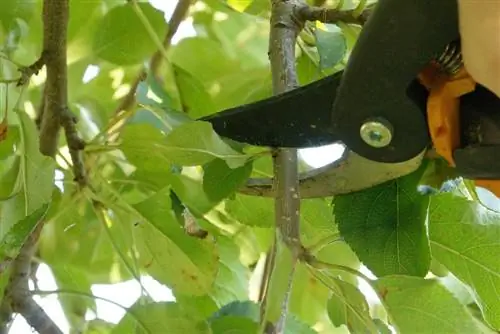
The innovative wound closure from Compo scores with several advantages. Unlike many other sealants, Lac Balsam is breathable. The product is easy to apply because it does not drip, dries quickly and provides reliable coverage. From a visual point of view, the advantage is that the paste is bark-colored, so that the treatment can only be seen upon closer inspection. Using the practical brush tube, the balm is distributed 2 cm beyond the edge of the wound after the area has been smoothed with a knife.
Tip:
Do not use wound closure in rain, frost or extreme heat. The ideal temperature range for maximum effectiveness is from 5 to 30 degrees Celsius.
Incision is more important than wound closure
Instead of treating a tree with counterproductive wound closure products after cutting, professional cutting provides valuable assistance in the healing process. Two rules of thumb summarize what is important:
- When cutting, only injure the tissue that belongs to the cut branch
- The smaller the cut, the more effective the encapsulation and healing
What does this mean specifically for the cut?
Most branch branches end in a clear bulge, the so-called astring or branch collar. This collar occurs because the tissue encloses both the thicker branch and the lower branch. If you now cut off the thinner branch, the branch should under no circumstances be affected. That's why tree experts talk about a 'cut on a branch', in which the scissors are placed a short distance from the bead.
A knothole is created at the interface because the tissue of the cut branch decomposes there. Here the cambium does its job and overflows the wound, resulting in the typical tree cavity. Due to the correct incision, only the tissue associated with the removed branch decomposes. All other parts of the tree remain unaffected by this process.
Cut wounds with a diameter of more than 5 cm are covered only very slowly or not at all. It therefore makes sense to prune a tree regularly and moderately, rather than rarely and radically. This prevents large wound areas that weaken the stability of the entire tree due to the formation of rot, regardless of whether wound closure agents have been applied or not.
Conclusion
This guide shows why wound closure products are no longer useful after a tree trimming. Extensive research results show that sealing cut surfaces significantly disrupts the self-healing powers of woody plants. At the same time, tree wax and the like do not contribute to protection against rot, fungi and bacteria. On the contrary, pathogenic germs feel safe under the seal. The exception to the waiver of wound closure applies to a cut in the middle of winter and as a result of bark detachment. In all other cases, professional pruning makes a significant contribution to ensuring that the wounded tree activates its self-healing powers and can quickly heal the wound.

